While several video games include Indigenous characters and themes, few have been made with creative control and design choices in the hands of people from whom these inspirations are drawn. That’s a big part of what makes Two Falls (Nishu Takuatshina), the upcoming first-person narrative adventure game from Unreliable Narrators, so notable. Not only is the studio working with partners from some of Canada’s First Nations, but it is ceding significant elements of creating control, giving their Indigenous collaborators a say over art, music, and the direction of the story.
I spoke with Laurène Betard, Two Falls brand manager, and Antoine Bartolo, general manager at Purple is Royal, the marketing team partnering with the studio. We discussed seeing the world through the Indigenous and European eyes, partnering closely with native communities to tell an authentic and respectful story, and what word they learned not to say during development.
It’s all about perspective
“Two Falls is a 3D narrative and exploration game about Indigenous history,” Laurène tells Digital Trends. “The story takes place in the 17th century in Canada, and you will follow the journey of two characters.“
One character is Jeanne, a French woman emigrating to what would one day become Quebec. She is the survivor of a shipwreck, alone with nothing but a dog to keep her company, and fearful of a wilderness she knows nothing about. The other is Maikan, an Innu hunter at home with the forests and animals that make up the natural landscape. Decisions made during gameplay will impact their independent but intertwining paths in this coming-of age-narrative.
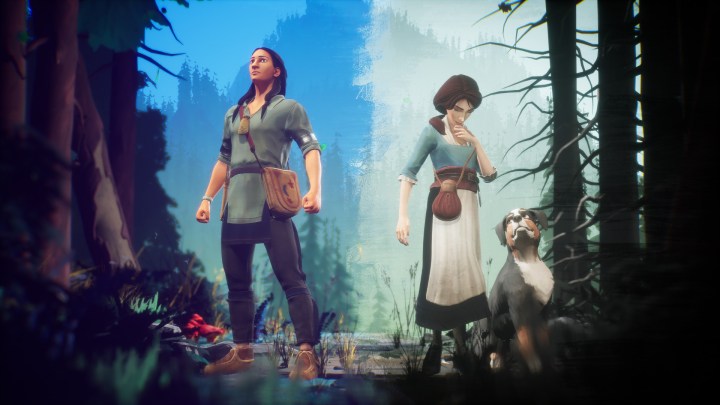
“Particular with this game is that we have [different] artistic directions in order to emphasize the two perspectives because it’s all a game about perspectives. How people can think or can see the things that surround them, but don’t see the same thing as another person.”
One example Laurène gives is the forest. To Jeanne, it’s frightening; She doesn’t recognize the trees or the sounds. Everything is dark, and blends together. For Maikan, it’s bright and colorful. He can recognize different trees, and signs of wildlife. It’s his people’s land, and he’s very comfortable. But it goes both ways.
“At some point,” Antoine begins,” there’s the shipwreck that Jeanne escaped from, you can see it from her perspective, which is just a shipwreck. It’s a ship that’s wrecked, but through the eyes of Maikan, the wood sticking out on the side kind of looks like a ribcage of a whale that could have been beached. It takes this kind of strange animalistic look because he’s not used to seeing such huge ships made out of wood and stuff like that. So we’re trying to play with all these things, too.”
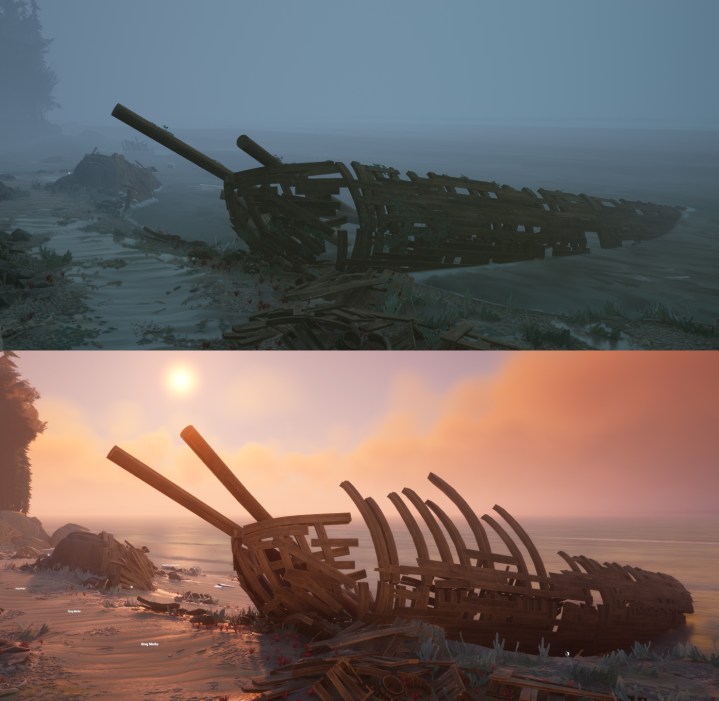
Laurène emphasizes that Two Falls is a first-person walking simulator (like Firewatch, from Campo Santo). You will be seeing things through the eyes of each character. That means when you are Jeanne, 3,000 miles from home in a strange new land, what may in fact be normal wildlife could appear to be something as frightening as a werewolf. And that’s not the only folklore that may be on the characters’ minds, as evident by the Windigo.
Laurène tells us, “I don’t know if you’re familiar with the story of the Windigo, but it’s an entity protecting the forest for Indigenous People. And when European people came, they were talking about Windigo as a bad spirit and evil spirits that will eat you if you don’t take care of the forest, but it’s not what Indigenous People created, you know, it’s more like a friendly entity in reality … For Jeanne, she will be frightened by the idea of the Windigo, while Maikan will be more intrigued by what is triggering the Windigo.”

Windigo, it turns out, was one of three different working titles in Two Falls‘ history. First, it was Kanata, named for the Huron-Wendat word for “settlement” or “village” which served as the origin for the name Canada. Then it was Windigo, but that name was later abandoned for good reason.
“While talking to people from different communities, we realized that [Windigo] was a term that we could not employ,” Antione says. “It’s something that’s not talked about, it’s kind of a Voldemort kind of thing. You’re not supposed to say that word and now we were just plastering it in big letters and trailers.”
Elevating and incorporating Indigenous voices
As interesting as these Indigenous legends and this era of history can be, it’s important to tell these stories the right way, with the right input from the peoples at the center of them. I asked Laurène and Antione about that, and they had a lot to say on the subject, starting with the central characters.
“Maikan was created with a lot of Indigenous partners, a lot of Wendat people, and some Innu too,” says Laurène. “ Maikan is a young hunter, so he sees his village afflicted by an illness, and this illness will force him to travel, to find the remedy. It’s how he’s beginning his journey. And there are a lot of moments in the game where you will really feel [his] Indigenous culture”.
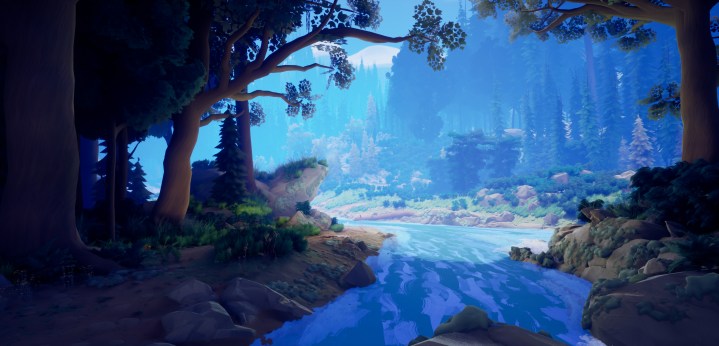
A key element to creating authentic characters is the voice acting. According to Laurène and Antonio, there will be both English and Innu dialogue, voiced by Indigenous actors.
Antione adds, “[among the Indigenous partners] we have internal staff at the studio. But what’s super important for the story is that we built what we call a Council of Elders, which is people from different Indigenous communities. And they kind of sign off on every step of the way, on the story, how we’re telling it, what we’re seeing in it, and also how items and stuff will be depicted in the game. So it’s super important for us to have that authenticity and to tell the story the way they want it to be told.”
It’s what Indigenous people want to say, how do they want us to finish?
The core story of Two Falls was crafted by Isabelle Picard, an Indigenous anthropologist. As the game developed it was reviewed by Tourisme Mashteuiatsh and the Tshakapesh Institute, two institutes that promote Indigenous culture and protect native languages. They provided confirmations and helped inform development, and that extended beyond just scenarios.
“Even in the simple details, like how Maikan is using his knife could change everything on what culture he is from. Innu people don’t do the same thing as Wendat people for example,” Laurène adds. “So we want to be as realistic as possible. And that’s why we had to choose a community, you know, like Innu. Maikan had to be Innu because we can’t say he is “indigenous” because that would have said something and nothing at the same time.”
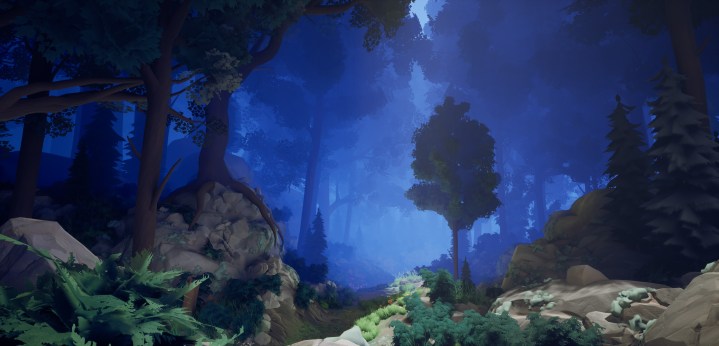
The influence of the Indigenous partners is difficult to overstate. Developer Unreliable Narrator has taken an approach that gives control to people from the cultures that the game is about.
“The 3D artists are not in Unreliable Narratives. It’s an external firm, which is Indigenous, created by Indigenous people,” Laurène says. “They already are both Wendat, so they already know a little bit about how people are clothed, and what clothes should look like. We are also making this concept validated by the Council [of Elders].”
Likewise, The music for Two Falls is done by an Indigenous artist, and even the final direction and tone of the story are intentionally left out of the hands of the development team.
“We are in the process of writing the end of the story because the end of the story is the most important part,” Laurène says. “It’s what Indigenous people want to say, how do they want us to finish? Do they want us to show something more sad, but maybe realistic, that shows all the damage that was done to this community? Or do they prefer to finish on a more positive note with a lot of hope and say, ‘OK, the collaboration will be possible.’ It’s up to them. We don’t have a say in this part. So I can’t tell you yet because we don’t know yet how it will finish.”
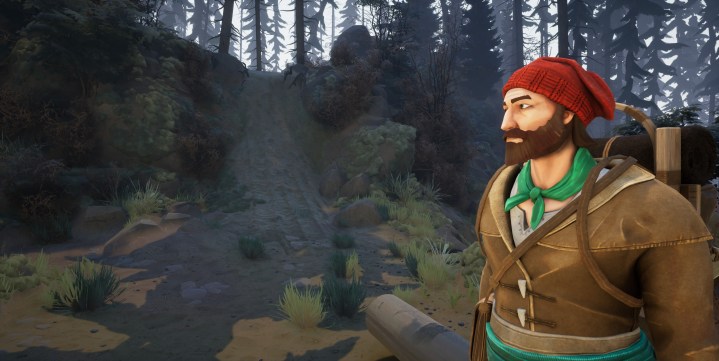
The Unreliable Narrator team is very clear about its intentions to engage with and listen to Indigenous communities. These influences are important for crafting the story and maintaining authenticity and creating a game that is responsible and respectful toward its subject matter.
Two Falls (Nishu Takuatshina) is planned to release in 2023 on Steam.
Editors’ Recommendations
Credit: Source link


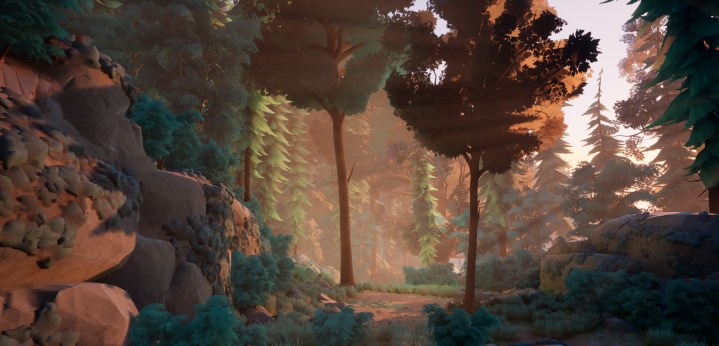
Comments are closed.